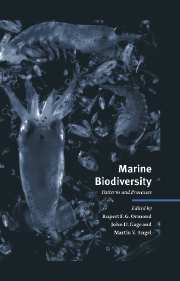Book contents
- Frontmatter
- Contents
- List of contributors
- Foreword: The value of diversity
- 1 Marine biodiversity in its global context
- 2 Gradients in marine biodiversity
- 3 Pelagic biodiversity
- 4 Biological diversity in oceanic macrozooplankton: More than counting species
- 5 Large-scale patterns of species diversity in the deep-sea benthos
- 6 Diversity, latitude and time: Patterns in the shallow sea
- 7 High benthic species diversity in deep-sea sediments: The importance of hydrodynamics
- 8 Diversity and structure of tropical Indo-Pacific benthic communities: Relation to regimes of nutrient input
- 9 Why are coral reef communities so diverse?
- 10 The biodiversity of coral reef fishes
- 11 The historical component of marine taxonomic diversity gradients
- 12 Population genetics and demography of marine species
- 13 Discovering unrecognised diversity among marine molluscs
- 14 Ecosystem function at low biodiversity – the Baltic example
- 15 Land–seascape diversity of the USA East Coast coastal zone with particular reference to estuaries
- 16 The development of mariculture and its implications for biodiversity
- 17 Protecting marine biodiversity and integrated coastal zone management
- 18 Conserving biodiversity in North-East Atlantic marine ecosystems
- Author index
- Species index
- Subject index
15 - Land–seascape diversity of the USA East Coast coastal zone with particular reference to estuaries
Published online by Cambridge University Press: 04 August 2010
- Frontmatter
- Contents
- List of contributors
- Foreword: The value of diversity
- 1 Marine biodiversity in its global context
- 2 Gradients in marine biodiversity
- 3 Pelagic biodiversity
- 4 Biological diversity in oceanic macrozooplankton: More than counting species
- 5 Large-scale patterns of species diversity in the deep-sea benthos
- 6 Diversity, latitude and time: Patterns in the shallow sea
- 7 High benthic species diversity in deep-sea sediments: The importance of hydrodynamics
- 8 Diversity and structure of tropical Indo-Pacific benthic communities: Relation to regimes of nutrient input
- 9 Why are coral reef communities so diverse?
- 10 The biodiversity of coral reef fishes
- 11 The historical component of marine taxonomic diversity gradients
- 12 Population genetics and demography of marine species
- 13 Discovering unrecognised diversity among marine molluscs
- 14 Ecosystem function at low biodiversity – the Baltic example
- 15 Land–seascape diversity of the USA East Coast coastal zone with particular reference to estuaries
- 16 The development of mariculture and its implications for biodiversity
- 17 Protecting marine biodiversity and integrated coastal zone management
- 18 Conserving biodiversity in North-East Atlantic marine ecosystems
- Author index
- Species index
- Subject index
Summary
Abstract
We propose a landscape-pattern approach for interpreting the ecological function of coastal-zone biodiversity. Our model incorporates pattern from the ecosystem to the species levels and predicts that the decline or removal of a species or a set of species will not only directly influence the total biological diversity of the system, but, by removing ecological feedbacks, will also influence environmental conditions. That is, predicting biodiversity and faunal dynamics both requires that the response of the organism to the environment, and the modifications the organism may make to the environment, be made explicit at appropriate scales. The implication is that by removing the possible feedbacks between these two environmental conditions, it is possible that functions of the entire coastal-zone ecosystem will be altered in fundamental ways.
The coastal zone may be subdivided into a hierarchical structure that is reflected by faunal pattern. The largest spatial scale we will consider is that of the coastal zone as transitional between land and sea on a continental scale. Smaller scales, respectively, are coastal provinces, estuarine systems and the mosaic of habitats within those systems. We identify three benthic invertebrate assemblages and four estuarine-dependent fish assemblages by means of principal components analysis (PCA); these assemblages generally reflect the boundary conditions of the Virginian and Carolinian biogeographical provinces. We then describe estuarine function in terms of five principal components; these are assumed to play fundamental roles in determining the occurrence and position of various habitats, including oyster reefs.
- Type
- Chapter
- Information
- Marine BiodiversityPatterns and Processes, pp. 337 - 371Publisher: Cambridge University PressPrint publication year: 1997
- 2
- Cited by



